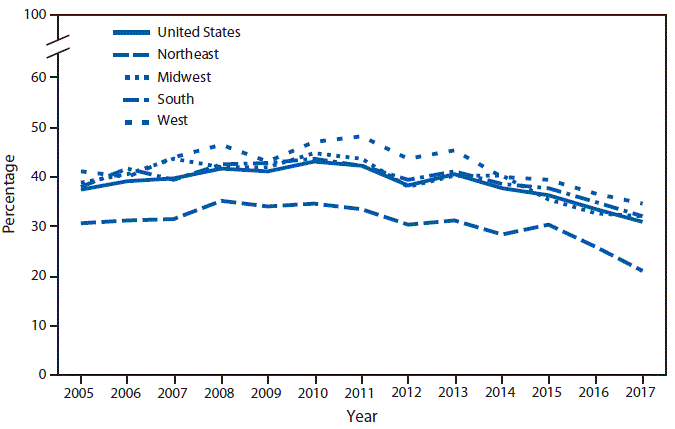QuickStats: Percentage of Emergency Department Visits for Pain* at Which Opioids† Were Given or Prescribed, by Geographic Region§ of the Hospital — United States, 2005–2017
Weekly / January 17, 2020 / 69(2);53

* Based on a sample of visits to emergency departments (EDs) in noninstitutional general and short-stay hospitals, exclusive of federal, military, and Veterans Administration hospitals, located in the 50 states and the District of Columbia. Pain-related visits were defined using up to three reasons for visit coded according to the National Center for Health Statistics Reason for Visit Classification (https://www.cdc.gov/nchs/data/series/sr_02/sr02_078.pdfpdf icon) and grouped using an algorithm from https://jamanetwork.com/journals/jama/fullarticle/1149438external icon.
† Visits with at least one opioid among up to eight medications listed as given in the ED or prescribed at discharge. Opioids were defined using the Cerner Multum third-level therapeutic category codes for narcotic analgesics (60) and narcotic analgesic combinations (191). Cold and cough products containing opioids and buprenorphine products indicated for conditions other than pain were excluded.
§ Northeast: Connecticut, Maine, Massachusetts, New Hampshire, New Jersey, New York, Pennsylvania, Rhode Island, and Vermont. Midwest: Illinois, Indiana, Iowa, Kansas, Michigan, Minnesota, Missouri, Nebraska, North Dakota, Ohio, South Dakota, and Wisconsin. South: Alabama, Arkansas, Delaware, District of Columbia, Florida, Georgia, Kentucky, Louisiana, Maryland, Mississippi, North Carolina, Oklahoma, South Carolina, Tennessee, Texas, Virginia, and West Virginia. West: Alaska, Arizona, California, Colorado, Hawaii, Idaho, Montana, Nevada, New Mexico, Oregon, Utah, Washington, and Wyoming.
The percentage of ED visits for pain at which an opioid was given or prescribed increased from 37.4% in 2005 to 43.1% in 2010 and then decreased to 30.9% in 2017. A similar pattern was observed in all four regions. Percentages for the Northeast were lower than for the nation as a whole for all years analyzed. In 2017, the percentage was 21.1% in the Northeast, compared with 32.0% in the Midwest, 32.0% in the South, and 34.7% in the West.
Source: National Center for Health Statistics. National Hospital Ambulatory Medical Care Survey, 2005–2017. https://www.cdc.gov/nchs/ahcd/ahcd_questionnaires.htm.
Reported by: Susan M. Schappert, MA, sschappert@cdc.gov, 301-458-4480; Loredana Santo, MD.
Suggested citation for this article: QuickStats: Percentage of Emergency Department Visits for Pain at Which Opioids Were Given or Prescribed, by Geographic Region of the Hospital — United States, 2005–2017. MMWR Morb Mortal Wkly Rep 2020;69:53. DOI: http://dx.doi.org/10.15585/mmwr.mm6902a6external icon.
MMWR and Morbidity and Mortality Weekly Report are service marks of the U.S. Department of Health and Human Services.
Use of trade names and commercial sources is for identification only and does not imply endorsement by the U.S. Department of
Health and Human Services.
References to non-CDC sites on the Internet are
provided as a service to MMWR readers and do not constitute or imply
endorsement of these organizations or their programs by CDC or the U.S.
Department of Health and Human Services. CDC is not responsible for the content
of pages found at these sites. URL addresses listed in MMWR were current as of
the date of publication.
All HTML versions of MMWR articles are generated from final proofs through an automated process. This conversion might result in character translation or format errors in the HTML version. Users are referred to the electronic PDF version (https://www.cdc.gov/mmwr) and/or the original MMWR paper copy for printable versions of official text, figures, and tables.
Questions or messages regarding errors in formatting should be addressed to mmwrq@cdc.gov.